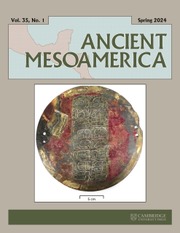No CrossRef data available.
Article contents
“The dear little flower babe has arrived!”: Blade stones, cradles, and child warriors in Ancient Mesoamerica
Published online by Cambridge University Press: 09 January 2025
Abstract
In the present discussion, I will focus on the creation of baby warriors in Mesoamerica in a twofold manner: as human beings and as blade stones. The emphasis will be on central Mexico, complemented with essential data from other parts of Postclassic Mesoamerica. By juxtaposing information from historical sources in a novel way, this investigation seeks to offer new insights that should reinforce the idea that warriors captured on the battlefield were considered to be children. Although this idea has been suggested before, this article aims to contribute new historical evidence that not only confirms this notion but also widens our understanding of the creation of nonbiological offspring. Making kin out of Others aims to satisfy a cosmological need to incorporate vital energy and elements for individual and collective personhood from outside of the community. The second idea of this investigation focuses on a related productive variant of this gestational dynamic, suggesting that by stone flaking and chipping, children (of stone) were fabricated. Some of them were indeed “child blade stones” who personified warriors and fed themselves with sacrificial victims, securing sustenance for the hungry gods. I argue that the birth of these warriors should be integrated into a major mythological theme—namely, the Child Hero and the Old Adoptive Mother.
Resumen
En la presente discusión, me enfocaré en la creación de bebés guerreros en Mesoamérica de una doble manera: como seres humanos, pero también como piedras sacrificiales. El énfasis estará en el Centro de México, pero se complementa con datos esenciales de otras partes del Postclásico Mesoamericano. Al yuxtaponer información de fuentes históricas de una manera novedosa, esta investigación busca ofrecer nuevos conocimientos que deberían reforzar la idea de que los guerreros capturados en el campo de batalla eran considerados como niños. Aunque esta idea ha sido sugerida anteriormente, este artículo pretende aportar nueva evidencia histórica que no solo confirme esta noción, sino que también amplíe nuestra comprensión de la creación de parentesco virtual. Hacer parientes de Otros (Vilaça 2002) pretende satisfacer una necesidad cosmológica de incorporar energía vital y elementos para la noción de persona, individual y colectiva, desde el exterior. La segunda idea principal de esta investigación se centra en una variante productiva relacionada con esta dinámica gestacional y sugiere que mediante el astillado de piedra se fabricaron hijos con raíces ancestrales. Algunos de ellos eran en realidad “piedras de cuchillos infantiles” que personificaban a los guerreros, se alimentaban con las víctimas de los sacrificios y aseguraban el sustento de los dioses hambrientos. En conclusión, argumento que el nacimiento de estos guerreros debe integrarse en un tema mitológico importante, a saber, el Niño Héroe y la Vieja Madre Adoptiva.
- Type
- Research Article
- Information
- Copyright
- Copyright © The Author(s), 2025. Published by Cambridge University Press



